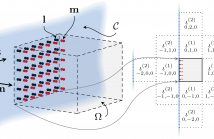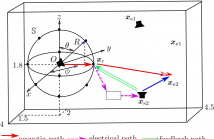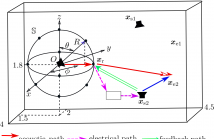
- Read more about Time domain Spherical harmonic analysis for adaptive noise cancellation over a spatial region
- Log in to post comments
Active Noise Cancellation (ANC) is a well researched topic for minimizing unwanted acoustic noise, and spatial ANC is a recently introduced concept that focuses on continuous spatial regions. Adaptive filter designing for spatial ANC is often based on frequency-domain spherical harmonic decomposition method, which has a major limitation due to the increased system latency. In this paper, we develop a time-domain spherical harmonic based signal decomposition method and use it to develop two time-space domain feed-forward adaptive filters for spatial ANC.
- Categories:
 23 Views
23 Views
- Read more about On the Comparison of Two Room Compensation / Dereverberation Methods Employing Active Acoustic Boundary Absorption
- Log in to post comments
In this paper, we compare the performance of two active dereverberation techniques using a planar array of microphones and loudspeakers. The two techniques are based on a solution to the Kirchhoff-Helmholtz Integral Equation (KHIE). We adapt a Wave Field Synthesis (WFS) based method to the application of real-time 3D dereverberation by using a low-latency pre-filter design. The use of First-Order Differential (FOD) models is also proposed as an alternative method to the use of monopoles with WFS and which does not assume knowledge of the room geometry or primary sources.
- Categories:
 23 Views
23 Views
- Read more about MODE DOMAIN SPATIAL ACTIVE NOISE CONTROL USING SPARSE SIGNAL REPRESENTATION
- Log in to post comments
Active noise control (ANC) over a sizeable space requires a large number of reference and error microphones to satisfy the spatial Nyquist sampling criterion, which limits the feasibility of practical realization of such systems. This paper proposes a mode-domain feedforward ANC method to attenuate the noise field over a large space while reducing the number of microphones required.
- Categories:
 32 Views
32 Views
- Read more about A NOVEL SELECTIVE ACTIVE NOISE CONTROL ALGORITHM TO OVERCOME PRACTICAL IMPLEMENTATION ISSUE
- Log in to post comments
Selective active noise control (SANC) is a method
to select a pre-trained control filter for different
primary noises, instead of using conventional
real-time computation of the control filter coefficients.
This paper:
1. Proves the frequency-band-match method.
2. Propose a SANC based on a partitioned frequency
domain filter.
3. Both simulation and real-time experiment is
carried out to validate the algorithm.
- Categories:
 29 Views
29 Views
- Read more about A Novel Selective Active Noise Control Algorithm to Overcome Practical Implementation Issue
- Log in to post comments
Selective active noise control (SANC) is a method to select a pre-trained control filter for different primary noises, instead of using conventional real-time computation of the
control filter coefficients. SANC has the advantage of improving the robustness of control filter while reducing the
computational complexity. This paper presents a practical
strategy in choosing a suitable control filter based on the
frequency-band-match mechanism implemented in a partitioned frequency domain filter structure. Both simulation and
- Categories:
 16 Views
16 Views
- Read more about Reference Signal Generation for Broadband ANC Systems in Reverberant Rooms
- Log in to post comments
One major issue of implementing broadband active noise control systems in reverberant
rooms is the lack of reference signals. In this work, by exploiting the spatial sound
field characteristics, a time-domain sound field separation method is developed to
generate the reference signal for broadband active noise control systems in reverberant
rooms. The time-domain sound field separation method separates the outgoing field produced
by the primary source from the secondary source feedback and room reverberation on a
- Categories:
 15 Views
15 Views
- Read more about Reference Signal Generation for Broadband ANC Systems in Reverberant Rooms
- Log in to post comments
One major issue of implementing broadband active noise control systems in reverberant
rooms is the lack of reference signals. In this work, by exploiting the spatial sound
field characteristics, a time-domain sound field separation method is developed to
generate the reference signal for broadband active noise control systems in reverberant
rooms. The time-domain sound field separation method separates the outgoing field produced
by the primary source from the secondary source feedback and room reverberation on a
- Categories:
 13 Views
13 Views
- Read more about Tutorial: Assisted Listening for headphones and hearing aids: Signal Processing Techniques
- Log in to post comments
With the strong growth of the mobile devices and emerging virtual reality (VR) and augmented reality (AR) applications, headsets are becoming more and more preferable in personal listening due to its convenience and portability. Assistive listening (AL) devices like hearing aids have seen much advancement. Creating a natural and authentic listening experience is the common objective of these VR, AR, and AL applications. In this tutorial, we will present state-of-the-art audio and acoustic signal processing techniques to enhance the sound reproduction in headsets and hearing aids.
- Categories:
 50 Views
50 Views
- Read more about Study on the use of error term in parallel-form narrowband feedback active noise control systems (slides)
- Log in to post comments
Parallel-form narrowband feedback active noise control (FBANC) system has been shown to perform better than conventional internal model control (IMC) based FBANC system in cancelling multi-tonal noise. A previous paper illustrated a novel approach in estimating the frequencies of the multi-tone noise, and using an internal tonal generator cum frequency grouping unit to increase its frequency separation in each channel of the parallel-form FBANC system based on a full-band error.
- Categories:
 8 Views
8 Views
- Read more about Study on the use of error term in parallel-form narrowband feedback active noise control systems
- Log in to post comments
Parallel-form narrowband feedback active noise control (FBANC) system has been shown to perform better than conventional internal model control (IMC) based FBANC system in cancelling multi-tonal noise. A previous paper illustrated a novel approach in estimating the frequencies of the multi-tone noise, and using an internal tonal generator cum frequency grouping unit to increase its frequency separation in each channel of the parallel-form FBANC system based on a full-band error.
- Categories:
 23 Views
23 Views